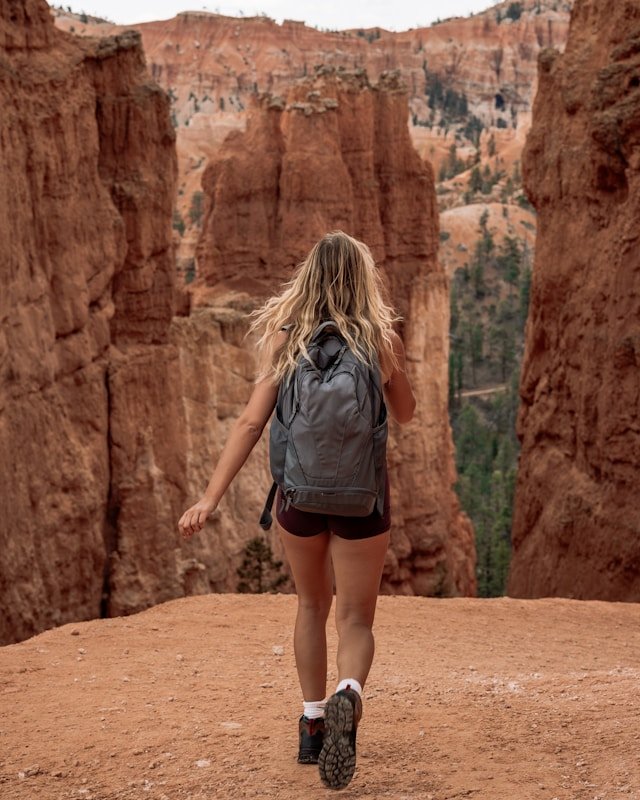Solo Travel Made Simple: Tips and Destinations for Your First Trip
Traveling solo for the first time can seem a bit intimidating, but it opens up a world of exciting opportunities. Whether you’re seeking adventure, culture, or relaxation, there are many destinations that cater to first-time solo travelers.
Some of the best places to explore include Amsterdam, Barcelona, and Bogotá—each offering unforgettable experiences, rich culture, and a welcoming vibe.
European cities like Amsterdam and Barcelona are famously safe and easy to explore, while Bogotá, Colombia, offers a more adventurous experience.
With a bit of awareness—sticking to well-traveled areas, using registered taxis, and keeping an eye on your belongings—Bogotá is just as rewarding, full of vibrant culture, history, and unforgettable views.
When you embark on a solo journey, you have the freedom to explore at your own pace and make spontaneous decisions. Imagine wandering through the picturesque canals of Amsterdam or soaking up the vibrant culture in Spain.
Each destination provides a blend of safety, accessibility, and plenty of activities to keep you engaged while meeting fellow travelers along the way.
As you plan your adventure, remember that solo travel is not just about the destination; it’s about the personal growth and confidence you gain along the way. Choose a place that excites you and take the plunge into an enriching experience that could shape your travels for years to come.
Choosing the Right Destination
Selecting a suitable destination for your first solo trip can significantly enhance your experience. It involves aligning your interests, understanding your comfort level, and being mindful of your budget.
Considering Your Interests
Think about what excites you. Are you drawn to vibrant city life, stunning natural landscapes, or immersive cultural experiences? This can guide your choice.
- Adventure Seekers: Destinations like Costa Rica offer jungles, hiking, and water sports.
- Cultural Enthusiasts: Cities such as Kyoto or Florence provide rich history and art.
- Beach Lovers: Consider destinations like Bali or the Greek Islands for relaxation.
Your interests will dictate the activities available to you, influencing both your enjoyment and social interactions with fellow travelers.
Assessing Your Comfort Zone
Prioritize your comfort when selecting a destination. Some travelers prefer bustling environments, while others may feel more at ease in quieter settings.
- Safety Levels: Research local safety reports and travel advisories.
- Language Barriers: Opt for places where English is commonly spoken if you’re not fluent in other languages.
- Solo-Friendly Culture: Look for destinations with a reputation for being welcoming to solo travelers, such as Iceland or New Zealand.
Understanding these aspects will help you feel secure and confident, allowing you to enjoy your journey fully.
Understanding the Cost
Budgeting is essential when choosing a destination. Different places come with varying costs for accommodation, food, and activities.
- Affordable Options: Southeast Asia offers great value for money, with low costs for meals and lodging.
- Higher-End Destinations: Western Europe can be pricier, so factor in expenses accordingly.
- Transportation Costs: Consider how you will get around. Some cities are walkable, while others may require public transport or taxis.
By understanding the financial landscape of your chosen destination, you can avoid surprises and plan a trip that meets your expectations without overspending.
Preparation and Research
Preparing for your first solo trip involves careful planning and research to ensure a smooth experience. You’ll want to pay attention to visa requirements, health considerations, and local customs to enhance your travel experience.
Visa Requirements and Safety
Before you travel, check the visa requirements for your chosen destination. Different countries have different regulations, and it’s crucial to ensure you have the appropriate visa to avoid complications upon arrival.
Key Steps:
- Visit Official Websites: Always consult the embassy or official government websites for accurate information.
- Application Process: Some visas can be obtained online, while others may require an in-person visit.
In addition to visas, prioritize your safety. Research the local crime rates and stay updated on travel advisories. It’s wise to share your travel itinerary with friends or family and have a local emergency contact.
Health Considerations
Maintaining your health while traveling is essential. Begin by checking if any vaccinations are required or recommended for your destination. Countries may have different health risks, so being informed helps you stay safe.
Important Health Tips:
- Health Insurance: Ensure you have travel insurance that covers medical expenses.
- Stay Hydrated: Drink plenty of water and be cautious about consuming food from unfamiliar sources.
Carry a basic medical kit for minor emergencies, including medications you may need. Knowing where the nearest hospital or clinic is located can also be helpful in case of unexpected health issues.
Local Etiquette and Customs
Understanding local customs and etiquette goes a long way in making your trip enjoyable. Research cultural norms to avoid unintentional faux pas.
Cultural Tips:
- Greeting Etiquette: Learn common greetings and gestures; for example, a handshake may be standard, while bowing is customary in some cultures.
- Dress Code: Be aware of local dress codes, especially when visiting religious sites.
Respect local traditions and participate in customs when appropriate. This not only enriches your experience but also shows respect for the culture and the people you meet.
Packing Tips for Solo Travelers
Packing for a solo trip requires thoughtful consideration to ensure you have everything you need while keeping your load manageable. Below are essential tips that will guide you in choosing the right gear and technology to enhance your travel experience.
Essential Travel Gear
When selecting travel gear, prioritize items that enhance safety and convenience. Start with a durable backpack that fits your body well and suits your travel style. Look for one with multiple compartments for easy organization.
Include a packing cube set to keep your clothing arranged and accessible. These cubes can save you time when unpacking. Don’t forget a lightweight rain jacket and a universally sized travel umbrella to handle unexpected weather.
A first aid kit is crucial for handling minor injuries on your own. Include basics such as adhesive bandages, antiseptic wipes, and over-the-counter pain relief. Lastly, invest in a reusable water bottle. Staying hydrated is key, and many places offer refill stations to reduce plastic use.
Travel Tech for Savvy Explorers
Technology can be your best friend while traveling solo. Begin with a portable charger to ensure your devices stay powered during long excursions. A power bank that can charge multiple devices is particularly useful.
Install key travel apps on your smartphone, such as Google Maps for navigation and Google Translate for communication in different languages. These tools help you confidently explore without getting lost.
Consider bringing a noise-canceling headphone for your flights or train rides. They help block out distractions, making your journey more pleasant. A lightweight tablet or e-reader can also entertain you during downtime. Download books or offline entertainment before your trip to make the most of your device.
Packing Light and Efficient
Packing light is essential for solo travelers. Start by choosing versatile clothing that can mix and match. Aim for a color palette that allows you to create multiple outfits with fewer pieces. This approach minimizes packing while maximizing wardrobe options.
Roll your clothes instead of folding to save space in your bag. This method also helps reduce wrinkles. Use compression bags if you’re short on space.
Only bring the toiletries you need in travel-sized containers. Plan to purchase any additional items at your destination if required. Finally, remember to leave room for souvenirs. You might discover unique items that you want to bring home!
Socializing and Making Connections
Connecting with others is one of the most rewarding aspects of solo travel. You’ll discover numerous opportunities to engage with fellow travelers and locals alike. Building relationships can enhance your experience and transform your journey.
Joining Group Tours and Activities
Participating in group tours is a fantastic way to meet people. Many destinations offer guided excursions tailored for solo travelers. Look for activities like walking tours, cooking classes, or adventure sports.
These adventures allow you to bond with others who share similar interests. Plus, guided tours help you navigate unfamiliar places while providing local insights.
Consider using platforms like Meetup or Airbnb Experiences. They often feature events specifically designed to connect travelers. This can lead to friendships or even long-lasting connections beyond your trip.
Using Social Media to Meet Locals
Social media is a powerful tool to enhance your travels. Platforms like Instagram and Facebook can connect you with locals who share similar passions.
Search for travel-focused groups or hashtags related to your destination. Engage in discussions and share your travel plans. Many locals are eager to offer advice or even meet up for coffee.
Use apps like Couchsurfing or Bumble BFF to find travel companions. These platforms allow you to connect directly with those in the area. It’s a smart way to explore local culture through personal connections.
Language and Communication Tips
Language barriers can be a challenge, but they shouldn’t hold you back. Start simple by learning basic phrases in the local language. This shows respect and willingness to connect.
Apps like Duolingo or Google Translate can make communication easier. You’ll find that even a few words can lead to meaningful interactions.
Whenever possible, approach locals with a smile. Body language and gestures can help bridge gaps. Be open-minded and patient; most people appreciate your effort to communicate.
Safety and Emergency Preparedness
Staying safe while traveling solo involves taking proactive measures and being prepared for unexpected situations. Knowing how to keep your belongings secure and who to contact in an emergency is essential.
Keeping Valuables Secure
To protect your valuables, use a money belt or a hidden pouch for important items like your passport, credit cards, and cash. Keeping these items close to you minimizes the risk of theft.
Consider using anti-theft bags designed with lockable zippers and cut-resistant straps. When in public, stay aware of your surroundings and avoid displaying expensive gadgets.
Be mindful when using ATMs. Choose machines located in well-lit, busy areas. Also, avoid withdrawing large sums of cash at once. Use hotel safes to store extra valuables when not in use.
Emergency Contacts and Insurance
Before your trip, compile a list of emergency contacts, including local authorities, your home country’s embassy, and travel insurance information. Save these contacts on your phone and carry a physical copy.
Make sure you have travel insurance that covers medical emergencies, trip cancellations, and lost belongings. Familiarize yourself with your policy details, ensuring you know how to file a claim if needed.
It’s also wise to inform someone back home of your itinerary and check in regularly. Sharing your plans helps ensure someone knows your whereabouts in case of an emergency.
Being Street Smart
Staying street smart is essential for your safety. You can blend in by dressing like a local and avoiding flashy jewelry that attracts attention.
It’s also a good idea to learn a few basic phrases in the local language. This can help you in conversations and emergencies.
Stay aware of your environment. If something feels off, trust your instincts and leave the area.
Also, avoid walking alone at night, especially in unfamiliar locations. You should utilize reliable transportation options, such as ride-sharing apps or registered taxis.
Before venturing into less populated areas, ensure you have a clear understanding of the local culture and any safety concerns related to those regions.


